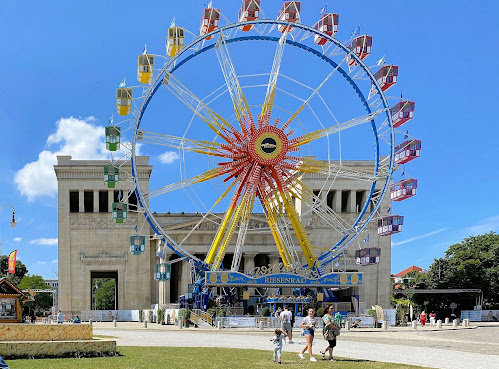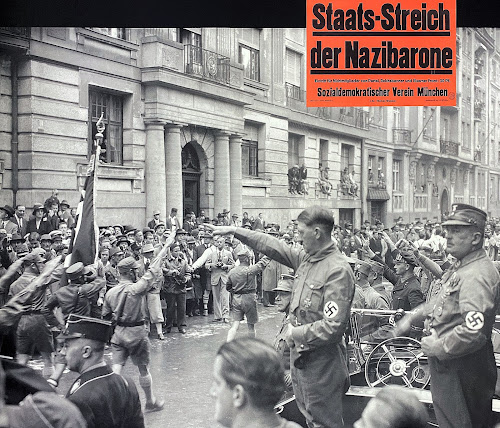... for the History of National Socialism is the long name for a building near Königsplatz that displays documents about Munich's darkest times, when the town was called the
Hauptstadt der Bewegung (The Capital of the Movement).
Last weekend, Red Baron was in Munich, from where he made a detour to Regensburg. I never visited Regensburg, although the city has a rich historical past that will be the subject of another blog.
When I arrived at Munich's central station by train around lunchtime, my first visit was to the nearby
Augustiner Biergarten.
 |
Roast pork with crackling, red cabbage, and potato dumplings.
Note the list of leaving addresses and telephone numbers. |
Following the Corona rules was disturbing, but I was comforted with a
Schweinsbraten and a local dark draft beer. I still remember my years as a student when it was hard to find Munich dark beer on draft, for people preferred pale lager then.
Following the copious meal, I walked down to Königsplatz and was surprised. The city allowed show-people to ride their funfair on Königsplatz to earn some money during the time of Corona.
Wenn das der Führer wüsste (If the Führer knew that) was an expression during the Nazi area when people noticed and commented on abuses of his satraps.
During the Third Reich, the Königsplatz was a "sacred" area. The aerial photo shows the square in 1937. Entering through the classical gate, you still find the
Glyptothek (sculpture gallery) on your left and
Antikensammlung (antique collection) on your right.
In the back, in the direction of the Karolinenplatz with its obelisk, are two identical impressive buildings. On the left is the former
Führergebäude, now the Music Academy. On the right is the former
Reichsleitung der NSDAP (the Reichs management of the Nazi Party), now the State Graphics Collection.
 |
Nazi putsch in Munich on Marienplatz on November 9, 1923.
The riot police shot and killed sixteen National Socialist comrades
when they were marching to Feldherrenhalle (Hall of Fame of military commanders) |
Besides, there are two low quadratic buildings in the photo of 1937, the
Ehrentempel (Honor Temples), housing the sarcophagi of the sixteen
Blutzeugen (blood witnesses or martyrs) of the party who died.
Here, Hitler commemorates the putsch of 1923 at the
Feldherrenhalle in 1935. Behind the Führer
Ernst Röhm, Reichsführer SA. The Social Democrats had blackmailed the "putsching" National Socialists as being the bootlickers of the industrial barons, i.e., the capitalists.
 |
| ©Damian Entwistle |
The "temples" were destroyed in 1947 by the US Army, but the foundations remained.
The Führer's Building became Munich's Amerikahaus.
 |
| More funfair. Note the tall white building on the left in the back. |
Just south of the "temple" foundations, the city of Munich built its Documentation Center.
 |
| Entrance to the Documentation Center |
The most unusual objects are on display in the foyer of the Documentation Center.
 |
| Book burning in Berlin at Opernplatz on May 10, 1933 (©Bundesarchiv/Georg Pahl). |
Covers of books are reproduced of "un-German" authors, books the Nazis had burned.
It did not work in Freiburg, for the stakes were rained out twice.
The following book covers are in alphabetical order by author. Note that
the list is by no means complete.
*























No comments:
Post a Comment